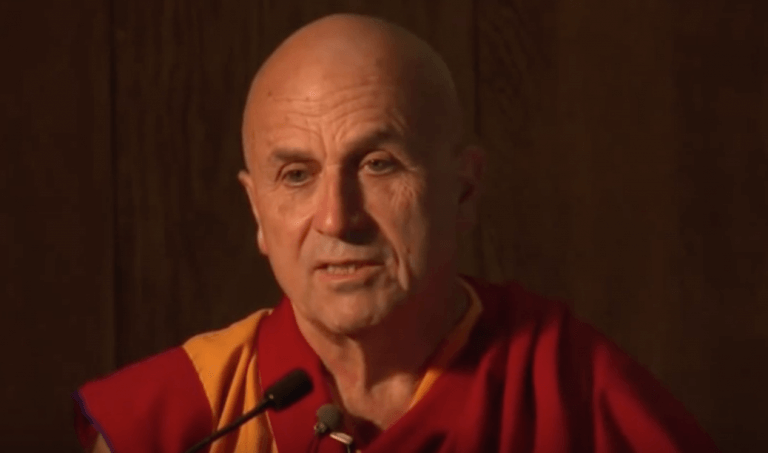Today we will talk about the biography of Matthieu Ricard, a French Buddhist monk and writer known as the happiest man in the world, who has lived in a monastery in Nepal for more than 37 years, where he was a disciple of great Buddhist masters. His spiritual adventure began in 1979, when he decided to change his brilliant scientific career to the study and practice of Tibetan Buddhism, contributing to the idea of unity between the West and the East, science and spirituality.
In addition to the many humanitarian projects he has developed, Matthieu Ricard is an active member of the Institute for Thought and Life, an institution that has been able to conduct various scientific research on mental training, meditation practices and brain plasticity.
- After a lifetime dedicated to the visionary projects of his teachers.
- We have compiled some of his tips for a good life.
- What can lead a man to completely abandon the success achieved so far and live in Nepal?How can a man of science give up?all to embrace spirituality?.
Matthieu Ricard was born in France in 1946. From a very young age he frequented the French intellectual circles to which his family belonged. His father was a philosopher, journalist and writer. His mother, a renowned painter, Matthew’s training was complemented by studies in classical music, photography and ornithology. A doctorate in molecular genetics from the Pasteur Institute, under the direction of one of his mentors, the French Nobel laureate Francois Jacob After completing his studies at the Pasteur Institute, Matthieu Ricard decided to leave the scientific world and focus on the practice of Tibetan Buddhism.
In 1972 he traveled to northern India and settled in the Himalayas, where he met and studied with several of the great Buddhist masters, in contact with Buddhist spirituality that led Ricard to become a disciple very close to the teacher Dilgo Khyentse Rinpoche. a visionary who dedicated his life to consolidating different eras, schools and monasteries. Places dedicated to the study and practice of Tibetan Buddhist teachings. Since the death of his teacher in 1991, Matthieu Ricard has dedicated himself to the continuation of the work he had begun. , dedicating all your time and effort.
There are 110 humanitarian projects in which Matthieu Ricard has participated and developed in Tibet, including the creation of dispensaries, schools and numerous bridges and infrastructure works, one of the schools was built to serve and train more than 800 orphans who arrived in Nepal across the Himalayan border. The school also welcomed hundreds of seniors.
Matthieu Ricard is co-director of the Shechen Buddhist Monastery in Nepal, in this place are developed the projects of Khyentse Rinpoche, who is also the author of a large number of books that help to unite and understand the cultural differences between East and West. the economic benefits obtained by their publications are intended to finance their humanitarian causes.
Ricard has laid the foundations for international distribution, securing important affiliates from around the world who have collaborated on their projects in Bhutan, Nepal and India. In recognition of his work to preserve Himalayan cultures, he was awarded the French National Order in 1989 by the French president. Francoise Mitterrand.
He accompanied the Dalai Lama’s last decades as a personal interpreter during his travels to French-speaking countries. He is a particularly active member of the Institute for Thought and Life, led by professor and neuroplasticity specialist Richard J. Davison. Ricardo has also participated in essays at Princeton University, Berkeley, Maastrich and Leipzig.
Matthieu Ricard also participated in a study by the University of Wisconsin, in which he underwent functional magnetic resonance imaging (fMRI) tests that generated spectacular data. Ricardo achieved the highest level of known human activity in the left prefrontal cortex.
The left prefrontal cortex is an area associated with positive emotions, something really significant. Matthieu Ricard reached levels of -0. 45, an extremely unusual result that earned him the nickname “the happiest man in the world. “The results of this study are the fifth most visited scientific reference in history.
Commenting on the title of the happiest man in the world and these amazing results, Ricard assured that he is not the only one, besides pointing out that the key is to train in meditation based on love and compassion, for him these results only demonstrate, once again, the great benefits of meditation. Moreover, in a way, it invites us to think that, perhaps, humanitarian work and the connection to spirituality, stripping of material, may also have contributed to some extent.
Matthieu Ricard’s work has been translated into 21 languages and sold in several countries. His entire literary work is a very valuable contribution to understanding human nature and the world. Titles such as: In defense of happiness, In defense of animals and Infinity in the Palme d’Hand, in which he talks about a conversation with the astrophysicist Trinh Xuan Thuan, and also establishes a dialogue between cultures.
Approaching Matthieu Ricard is approaching spirituality. An attempt at reconciliation between the West and Buddhism. At the same time, reading his works is totally inspiring and thoughtful. Happiness may not be as far as it seems, but it requires effort and dedication.
“This book is the inspiring result of a deeply interesting dialogue between Western science and Buddhist philosophy. Does it contribute to a better understanding of the true nature of our world and how we live our lives?-S. S. D. Dalai Lama-

